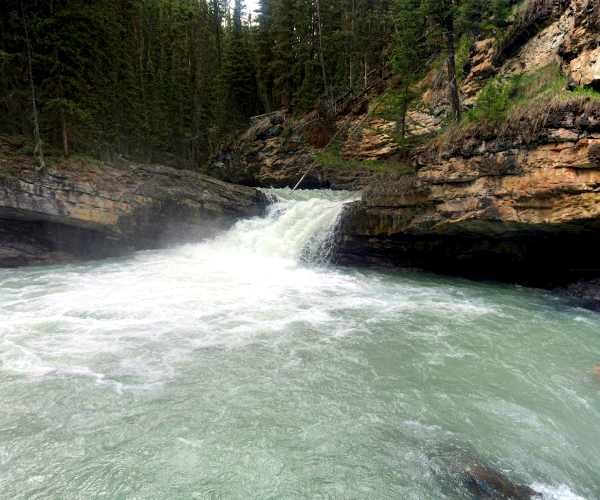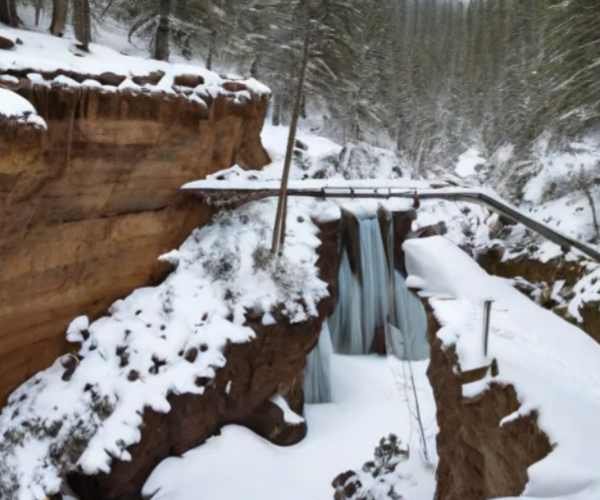Johnston Canyon, nestled in Banff National Park, is a must-visit destination for hikers and nature enthusiasts. Deciding whether to explore this stunning canyon in winter or summer can be tough, as each season offers unique experiences. In summer, vibrant greenery and rushing waterfalls create a lively atmosphere, ideal for hiking and photography. In winter, frozen waterfalls and snow-covered trails transform the canyon into a serene wonderland, perfect for ice walks and quiet reflection. This guide compares Johnston Canyon in both seasons, detailing trails, activities, weather, accessibility, and more to help you plan the perfect visit.
We break down the pros and cons of visiting Johnston Canyon in winter versus summer. Through lists, tables, and practical tips, we ensure you have all the information needed to make an informed decision. Whether you’re drawn to the icy beauty of winter or the lush vibrancy of summer, this guide has you covered.
Why Visit Johnston Canyon?
Johnston Canyon is one of Banff’s most accessible and scenic attractions, located just 25 km from Banff townsite along the Bow Valley Parkway. Its well-maintained trails lead to breathtaking waterfalls, including the Lower Falls and Upper Falls, making it a year-round favorite. The canyon’s unique limestone formations, carved by Johnston Creek, create a dramatic landscape that changes with the seasons. Whether you’re a beginner hiker or an experienced adventurer, the canyon offers something for everyone.
For a deeper dive into Banff’s attractions, check out our guide on What is Banff Famous For? to explore more iconic spots in the area.
Johnston Canyon in Summer: A Vibrant Adventure

Summer in Johnston Canyon, from June to August, is peak season, drawing crowds for its warm weather and lush scenery. The trails are snow-free, waterfalls flow vigorously, and wildlife is abundant. Here’s a detailed look at what summer offers.
Summer Highlights: Why Visit Johnston Canyon in June, July, or August?
- Lush Scenery: The canyon is surrounded by dense forests, wildflowers, and vibrant greenery, creating a postcard-perfect setting.
- Accessible Trails: Dry, well-maintained paths make hiking to the Lower and Upper Falls easy for all skill levels.
- Wildlife Sightings: Summer is prime time to spot birds, squirrels, and occasionally larger animals like deer or bighorn sheep.
- Photography Opportunities: The sunlight filtering through the trees and the sparkling waterfalls provide stunning photo ops.
- Extended Daylight: Long days allow for leisurely exploration and combining the hike with other Banff activities.
Summer Trail Details
| Trail | Distance (Round Trip) | Difficulty | Highlights | Estimated Time |
|---|---|---|---|---|
| Lower Falls | 2.4 km | Easy | Scenic walkway, waterfall views, bridge crossing | 1–1.5 hours |
| Upper Falls | 5.2 km | Moderate | Taller waterfall, steeper sections, catwalks | 2–3 hours |
| Ink Pots | 11.6 km | Moderate | Colorful mineral springs, open meadows | 4–5 hours |
Summer Activities in Johnston Canyon
- Hiking: The trails to the Lower and Upper Falls are perfect for families and beginners. For a longer adventure, continue to the Ink Pots, a series of vibrant mineral springs.
- Photography: Capture the cascading waterfalls and lush forest scenes. Early mornings offer softer light and fewer crowds.
- Wildlife Watching: Bring binoculars to spot birds like dippers or mammals along the trail. Learn more about Where to See Wildlife in Banff for tips on spotting local fauna.
- Picnicking: Several spots along the trail offer scenic areas to enjoy a packed lunch.
Summer Weather and What to Expect
Summer temperatures in Johnston Canyon range from 15°C to 25°C (59°F to 77°F), with occasional rain showers. The trails can get muddy after rain, so waterproof shoes are recommended. Crowds peak in July and August, so arrive early to secure parking and avoid congestion.
For more on summer in Banff, explore our Banff Summer Activities Guide to plan a full itinerary.
Summer Pros and Cons
| Pros | Cons |
|---|---|
| Warm, comfortable weather | Crowded trails and parking lots |
| Vibrant greenery and active waterfalls | Higher accommodation costs |
| Long daylight hours for exploration | Occasional rain can make trails slippery |
| Abundant wildlife sightings | Busy atmosphere, less solitude |
Johnston Canyon in Winter: A Frozen Wonderland

Winter, from December to March, transforms Johnston Canyon into a magical icy landscape. Frozen waterfalls, snow-laden trees, and quiet trails create a peaceful experience. The popular Johnston Canyon Ice Walk is a highlight, drawing visitors to its sparkling ice formations.
Winter Highlights: Why Visit Johnston Canyon in December, January, or February?
- Frozen Waterfalls: The Lower and Upper Falls freeze into stunning ice sculptures, a sight unlike any other.
- Ice Walks: Guided or self-guided ice walks offer a unique way to explore the canyon’s icy beauty.
- Fewer Crowds: Winter sees fewer visitors, providing a more serene experience.
- Snowy Scenery: The snow-covered canyon is a photographer’s dream, with soft light enhancing the icy landscapes.
- Winter Activities Nearby: Pair your visit with skiing or snowboarding in Banff. Check out our Skiing, Snowboarding, and Banff Hot Springs Guide for winter activity ideas.
Winter Trail Details
| Trail | Distance (Round Trip) | Difficulty | Highlights | Estimated Time |
|---|---|---|---|---|
| Lower Falls Ice Walk | 2.4 km | Easy | Frozen waterfall, icy catwalks, snow-covered trees | 1.5–2 hours |
| Upper Falls Ice Walk | 5.2 km | Moderate | Larger frozen waterfall, icier trails | 2.5–3.5 hours |
| Ink Pots (Snowshoe) | 11.6 km | Moderate to Hard | Snow-covered springs, winter solitude | 5–6 hours |
Winter Activities in Johnston Canyon
- Ice Walking: Walk on frozen trails to see the ice-covered waterfalls. Guided tours provide crampons and insights into the canyon’s geology.
- Snowshoeing: The trail to the Ink Pots is ideal for snowshoeing, offering a quiet, immersive experience.
- Photography: The contrast of ice and snow creates dramatic shots. Tripods are useful for low-light conditions.
- Wildlife Tracking: Look for animal tracks in the snow, such as those of rabbits or deer.
Winter Weather and What to Expect
Winter temperatures range from -15°C to 0°C (5°F to 32°F), with heavy snowfall possible. Trails can be icy, so microspikes or crampons are essential. Dress in layers, including a waterproof jacket, gloves, and a hat. Parking is easier in winter, but arrive by mid-morning to avoid afternoon crowds.
For more winter planning, visit Parks Canada’s Banff National Park page for trail updates and safety tips.
Winter Pros and Cons
| Pros | Cons |
|---|---|
| Stunning frozen waterfalls | Cold temperatures require heavy clothing |
| Fewer crowds, more solitude | Icy trails can be slippery without proper gear |
| Unique ice-walking experience | Shorter daylight hours limit exploration |
| Lower accommodation costs | Limited wildlife sightings |
Comparing Johnston Canyon: Winter vs. Summer
To help you decide, here’s a head-to-head comparison of key factors.
Weather and Comfort
| Factor | Summer | Winter |
|---|---|---|
| Temperature | 15°C to 25°C (59°F to 77°F) | -15°C to 0°C (5°F to 32°F) |
| Precipitation | Occasional rain | Frequent snow |
| Comfort | Light clothing, sunscreen | Heavy layers, crampons |
Verdict: Summer is more comfortable for those who prefer milder weather, while winter appeals to those who enjoy crisp, cold air and don’t mind bundling up.
Trail Accessibility
| Factor | Summer | Winter |
|---|---|---|
| Trail Condition | Dry, well-maintained | Icy, snow-covered |
| Gear Needed | Hiking shoes, water | Microspikes, warm layers |
| Difficulty | Easier, less slippery | Moderate, requires caution |
Verdict: Summer trails are more accessible for beginners, while winter requires preparation and proper gear.
Scenery and Photography
| Factor | Summer | Winter |
|---|---|---|
| Visual Appeal | Lush greenery, flowing waterfalls | Frozen waterfalls, snowy landscapes |
| Lighting | Bright, long daylight | Soft, shorter daylight |
| Unique Features | Wildflowers, wildlife | Ice formations, snow patterns |
Verdict: Both seasons offer stunning scenery, but summer is vibrant and lively, while winter is serene and dramatic.
Crowds and Cost
| Factor | Summer | Winter |
|---|---|---|
| Crowds | High, especially July–August | Low, except holidays |
| Parking | Limited, arrive early | Ample, easier access |
| Costs | Higher (accommodation, tours) | Lower (off-season rates) |
Verdict: Winter offers a quieter, more budget-friendly experience, while summer is busier and pricier.
Activities and Experiences
| Factor | Summer | Winter |
|---|---|---|
| Main Activity | Hiking, wildlife watching | Ice walking, snowshoeing |
| Nearby Options | Boating, biking | Skiing, snowboarding |
| Unique Experience | Ink Pots hike | Frozen waterfall views |
Verdict: Summer suits those seeking diverse outdoor activities, while winter is ideal for unique icy adventures.
Practical Tips for Visiting Johnston Canyon
Packing List for Summer
- Lightweight hiking shoes with good grip
- Water bottle and snacks
- Sunscreen and insect repellent
- Camera or smartphone for photos
- Rain jacket for sudden showers
Packing List for Winter
- Insulated, waterproof boots
- Microspikes or crampons
- Layered clothing (base layer, fleece, waterproof jacket)
- Hand and foot warmers
- Headlamp for early or late visits
Safety Tips
- Check Trail Conditions: Visit Banff National Park’s official website for updates on closures or hazards.
- Stay on Trails: Avoid stepping off designated paths to prevent erosion or slips.
- Travel in Groups: Especially in winter, hike with others for safety.
- Carry Bear Spray: Bears are active in summer, so be prepared. Learn more from Alberta Parks’ bear safety guide.
Getting to Johnston Canyon
Johnston Canyon is easily accessible by car from Banff (25 km) or Lake Louise (33 km) via the Bow Valley Parkway. Public transit options are limited, but shuttles from Banff are available in summer. For detailed directions, see our guide on How to Get to Banff: Best Routes from Major Cities.
Personal Experience: My Johnston Canyon Adventure
Last summer, I visited Johnston Canyon on a sunny July morning. The trail to the Lower Falls was bustling but manageable, and the sound of the rushing water was mesmerizing. The Upper Falls hike was steeper but worth it for the view. I even spotted a dipper bird diving into the creek! In contrast, my winter visit in January was quieter. The frozen waterfalls were jaw-dropping, and the ice walk felt like stepping into a fairy tale. Both experiences were unforgettable, but winter’s solitude won me over.
Which Season is Right for You?
- Choose Summer If:
- You love warm weather and vibrant scenery.
- You want to combine hiking with other Banff activities like boating or biking.
- You’re traveling with kids or prefer easier trails.
- Choose Winter If:
- You’re drawn to unique icy landscapes and frozen waterfalls.
- You prefer fewer crowds and a peaceful experience.
- You enjoy winter activities like ice walking or snowshoeing.
Conclusion
Johnston Canyon is a year-round gem in Banff National Park, offering distinct experiences in summer and winter. Summer brings lush trails, active waterfalls, and wildlife, while winter transforms the canyon into a frozen paradise with ice walks and snowy serenity. By comparing weather, trails, activities, and costs, this guide helps you decide which season suits your preferences. Whether you choose the vibrant energy of summer or the tranquil beauty of winter, Johnston Canyon promises an unforgettable adventure.
Plan your visit today, and don’t forget to explore nearby attractions like the Banff Upper Hot Springs for a relaxing post-hike soak!

